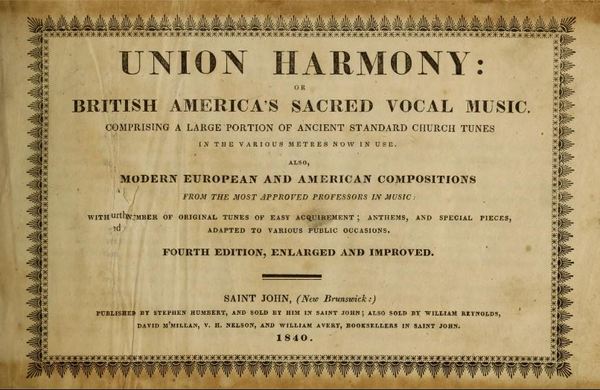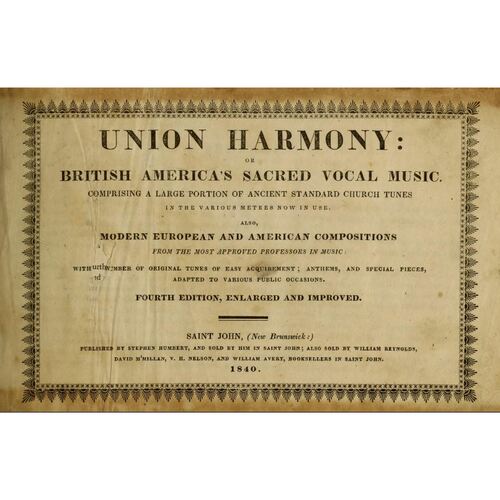
Source: Link
HUMBERT, STEPHEN, baker, merchant, politician, militia officer, office holder, Methodist lay leader, singing teacher, author, and musician; b. 1766 or 1767 in New Jersey, son of Stephen Humbert and Elizabeth —; m. first Martha —, and they had at least two sons and three daughters; m. secondly 25 Oct. 1818, in Boston, Mary Adams, née Wyer, and they had at least three daughters, one of whom died in infancy; d. 16 Jan. 1849 in Saint John, N.B.
Stephen Humbert spent the revolutionary years working in New York with his father, a baker, before his loyalist family immigrated to Parrtown (Saint John) in 1783. He continued working in his father’s trade, but soon developed diverse commercial and personal interests. Humbert’s business expanded to include shipping and general merchandising. He also built a book and music shop on the lower floor of his home, located on the South Market Wharf in Saint John.
Humbert sat as alderman on the Saint John Common Council for some years in the period 1812–22. He also served as a member of the New Brunswick House of Assembly for the city of Saint John from 1809 to 1820, when he was defeated in his bid for re-election by Hugh Johnston. In that year he became preventive officer, charged with breaking up the illegal plaster of Paris trade between New Brunswick and the United States; his son John served as his deputy. Stephen had perhaps been prepared for the dangerous duties of this position by his service in the militia. He had been appointed a captain in the Saint John County regiment in 1805 and had served throughout the War of 1812 and beyond. Defeated when he again stood for the assembly in 1827, Humbert protested to the house, alleging undue election, but later withdrew his petition against the successful candidate, Robert Parker*. In the general election of 1830 he was returned for Saint John County and City, and he served to 1834, losing in the election that year. John Humbert sat in the house as member for Kings County from 1827 to 1834.
A Methodist, Stephen Humbert took an active part in the organization of the first Methodist society in Saint John, founded in 1791. By his own account he preached for several years as a lay leader in the Saint John chapel and periodically carried full responsibility for the congregation in the absence of an ordained minister. He worked closely with the Nova Scotian Methodist leader William Black*, with Abraham John Bishop, the first Methodist exhorter to be stationed in Saint John, and with James Man*, who served for a time on the Saint John circuit. Humbert’s Rise and progress of Methodism, in the province of New Brunswick, printed in 1836 by Lewis W. Durant and Company of Saint John, describes the establishment of the Methodists there between 1791 and 1805. The book documents the turnover from North American to British Methodist authority and the tensions that accompanied this change. To his bitter dismay Humbert lost his leadership role in the Saint John chapel to Joshua Marsden, a missionary sent out to the Maritime colonies by the British Wesleyan Conference in 1800. For a time Humbert preached in nearby Carleton. About 1805, at the request of its members, he resumed preaching in the Saint John chapel, in the absence of Marsden’s successor, William Bennett*, another British Methodist. Since his differences with the British Methodists could not be resolved, however, he eventually set himself up in opposition to the main chapel, conducting his services in a room that had been offered to him. When mediation by William Black failed, Humbert appears to have severed his connection with the Saint John chapel.
Humbert is perhaps best known as a singing-school leader, a composer, and the compiler of the first English tune-book published in Canada. In October 1796 he advertised the opening of a singing school in a large upper room on King Street. There he taught singing techniques and the rudiments of music theory, working primarily with a repertoire of sacred vocal music drawn from New England tune-books. Singing schools had been popular in the American colonies since the 1720s, providing recreation as well as instruction. Often conducted by itinerant singing masters, such schools would last from six to eight weeks, classes being held three evenings per week, and would conclude with a formal concert to display the participants’ new vocal skills. Saint John was fortunate to have had a resident singing master.
To meet the needs of his singing-school classes Humbert compiled his own tune-book, which he had printed in New England in 1801. That November he advertised “the union, harmony, or British America’s sacred vocal music” as ready for sale in Saint John, Fredericton, Annapolis Royal, and Halifax (where Thomas Daniel Cowdell* acted as his agent). The volume contained an introduction on the principles of vocal music and a collection of anthems, hymn tunes, and texts selected by Humbert from the New England tune-books available to him. According to his advertisements, the 1801 edition contained a number of original tunes by the compiler. The second edition, printed late in 1816 or early in 1817 by C. Norris and Company of Exeter, N.H., was “much improved and enlarged.” It included a comprehensive “Introduction to the Grounds of Musick,” with vocal exercises, borrowed verbatim from the 1817 edition of The village harmony, or youth’s assistant to sacred musick . . . , a popular New Hampshire tune-book, as well as a large complement of British tunes and anthems and a number of original tunes. Some of Humbert’s own works bore distinctive titles, such as “St. John,” “Gagetown,” “Sussex Vale,” “Halifax,” “Carleton Side,” and “Frederickton.” The texts were set in three or four parts with the tune placed in the tenor voice according to contemporary custom. Union harmony was intended for use primarily as a singing-school textbook, but Humbert ambitiously hoped that it might also serve as an anthem- and hymn-book. Indeed, he may have increased the number of British tunes in the second edition to make the work more suitable for use in British Methodist and Anglican church services. The volume was reissued with additional new materials in 1831 and 1840. Humbert appears to have continued conducting periodic singing schools in Saint John until at least 1840 when he founded a sacred music society.
Humbert’s “Singing School” song describes a typical singing school of his day. Written in the fuguing style, a music idiom popular among North Arnerican composers in the 18th century, its staggered musical entries were designed to show off each vocal section of the newly trained choir.
’Tis pleasing to my pensive mind,
To recollect the hours,
When socially we all combin’d,
To exert our vocal powers.
Oft we beguil’d the winter eve,
Forgot the chilling storm,
The charms of music to receive,
The sacred notes perform.
No copy of the 1801 edition of Humbert’s tune-book has been found. The second edition is entitled Union harmony: or British America’s sacred vocal musick, from the most approved English and American composers, with some original musick on special occasions, to which is prefixed a concise introduction (Saint John, N.B., 1816). Information about its contents presented in this biography is based on Nicholas Temperley, “Stephen Humbert’s Union harmony, 1816,” ‘Sing out the Glad News’: hymn tunes in Canada, ed. John Beckwith (Toronto, 1987), and on Temperley’s hymn-tune indexing project at the Univ. of Ill. (Urbana-Champaign), in preparation. For the publication history of Union harmony, including locations of copies, see Barclay McMillan, “Tune-book imprints in Canada to 1867: a descriptive bibliography,” Biblio. Soc. of Canada, Papers (Toronto), 16 (1977): 31–57. The full title of Humbert’s history of Methodism in Saint John is The rise and progress of Methodism, in the province of New Brunswick, from its commencement until about the year 1805 (Saint John, 1836).
National Gallery of Canada (Ottawa), J. R. Harper papers, J. R. Harper, “Spring tide: an enquiry into the lives, labours, loves and manners of early New Brunswickers.” PANB, MC 1156, VII (copy at N.B. Museum). Saint John Regional Library, “Biographical data relating to New Brunswick families, especially of loyalist descent,” comp. D. R. Jack (4v., typescript), 2: 129. New-Brunswick Courier, 20 Jan. 1849. New-Brunswick Royal Gazette (Saint John; Fredericton), 1 Sept., 3 Nov. 1801; 12 Oct. 1816. St. John Gazette, and Weekly Advertiser (Saint John), 4 Nov. 1796. Encyclopedia Canadiana. Encyclopedia of music in Canada, ed. Helmut Kallmann et al. (Toronto, 1981), 438, 837–38. W. G. MacFarlane, New Brunswick bibliography: the books and writers of the province (Saint John, 1895). N.B. vital statistics [1754–1852] (Johnson et al.). PANB, “A new calendar of the papers of the House of Assembly of New Brunswick,” comp. R. P. Nason et al. (3v., typescript, Fredericton, 1975–77). Clifford Ford, Canada’s music: an historical survey (Agincourt [Toronto], 1982), 29–30. Helmut Kallmann, A history of music in Canada, 1534–1914 (Toronto and London, 1960). MacNutt, New Brunswick.
Cite This Article
Margaret Filshie Leask, “HUMBERT, STEPHEN,” in Dictionary of Canadian Biography, vol. 7, University of Toronto/Université Laval, 2003–, accessed January 9, 2026, https://www.biographi.ca/en/bio/humbert_stephen_7E.html.
The citation above shows the format for footnotes and endnotes according to the Chicago manual of style (16th edition). Information to be used in other citation formats:
| Permalink: | https://www.biographi.ca/en/bio/humbert_stephen_7E.html |
| Author of Article: | Margaret Filshie Leask |
| Title of Article: | HUMBERT, STEPHEN |
| Publication Name: | Dictionary of Canadian Biography, vol. 7 |
| Publisher: | University of Toronto/Université Laval |
| Year of publication: | 1988 |
| Year of revision: | 1988 |
| Access Date: | January 9, 2026 |



